 English
EnglishThe purpose of tone threshold audiometry is to determine the thresholds of auditory perception (levels of the lowest intensity still perceived by the subject) of a person. This is a subjective study, as it is based on the auditory sensations of the subject.
For diagnostic purposes, the state of hearing by air conduction is most often examined. For clinical purposes, it is also customary to conduct a study of the state of hearing by bone conduction, and also to determine not only the thresholds of auditory perception, but also the thresholds of discomfort.
 For the test to be successful, certain conditions are necessary: ideally, this is a special soundproof room. Another way to create appropriate conditions is to use a sound-damped camera and special ear pads. If the study is carried out in unsuitable conditions, it must be remembered that the results of audiometry can be affected by ambient noise, which is expressed in an increase in the determined hearing thresholds.
For the test to be successful, certain conditions are necessary: ideally, this is a special soundproof room. Another way to create appropriate conditions is to use a sound-damped camera and special ear pads. If the study is carried out in unsuitable conditions, it must be remembered that the results of audiometry can be affected by ambient noise, which is expressed in an increase in the determined hearing thresholds.
Tonal threshold audiometry is carried out using audiometers, which are different for different manufacturers, but they all have some common parameters:
– a set of frequencies from 125 Hz to 8 kHz (the upper frequency limit can vary from 6 to 16 kHz);
– sound intensity (loudness) range – from 0 (-10) dB to 100 (120) dB;
– stimulation – with a pure tone signal or narrow-band noise.
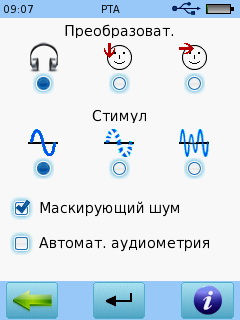 To perform a pure tone audiometry study, the audiometer must be equipped with special calibrated headphones. A bone vibrator is required to perform a bone conduction hearing test. In addition, often audiometers are equipped with a patient response button.
To perform a pure tone audiometry study, the audiometer must be equipped with special calibrated headphones. A bone vibrator is required to perform a bone conduction hearing test. In addition, often audiometers are equipped with a patient response button.
To study hearing by air conduction, air telephones (headphones that are installed on the ears) are used, and by bone conduction, a bone vibrator (which is usually installed on the mastoid process or on the forehead) is used. If it is necessary to use masking to exclude “overhearing”, a signal is given to the opposite ear using air telephones.
Hearing testing starts with the best hearing ear. If it is impossible to determine which ear hears better, usually the study begins on the right (in left-handed people on the left). A pure tone of one frequency is presented through air telephones or a bone vibrator. Usually start at 1 kHz, then search for thresholds successively at higher frequencies. After that, the threshold value is rechecked at a frequency of 1 kHz and then hearing is examined at lower frequencies. The study at each frequency begins with the level of intensity that will be heard for sure. Then the level is reduced in 10 dB steps until the perception disappears, then it is increased in 5 dB steps until the auditory sensation appears. The threshold value is applied to the audiogram form.
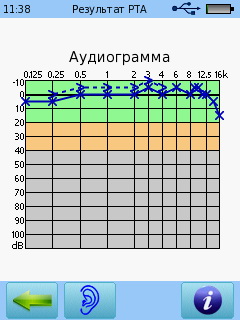
If the hearing loss is symmetrical, then the obtained threshold values correspond to reality. But you should always remember about the possibility of “overhearing” – hearing the signals given to the tested ear, the opposite ear. It occurs when the level difference in air conduction is 40-60 dB, in bone conduction – 0-15 dB (depending on frequency). Therefore, when there is a danger of “overhearing” – they use masking – giving a signal of the appropriate level to the other ear (to prevent overhearing).
All results – air and bone conduction hearing thresholds – are displayed on an audiogram. It also indicates if some threshold values were obtained using masking. As a result, a curve is obtained that displays the deviations of the thresholds of auditory perception from the norm for different sounds and frequencies, that is, a graphical reflection of the testee’s ability to hear tonal sounds at different frequencies and perceive speech intelligibly.
Normally, the thresholds of air and bone sound conduction coincide and are within 5-10 dB.
If the thresholds of auditory perception are higher than normal, and the curves of the thresholds for air and bone conduction coincide, this is a case of sensorineural hearing loss.
If the thresholds of auditory perception for air and bone conduction do not match, this is an air-bone rupture, there is a conductive component in hearing loss. If the hearing thresholds for bone conduction are within the normal range, this is conductive hearing loss, if not, then it is mixed.
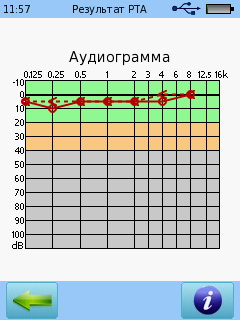
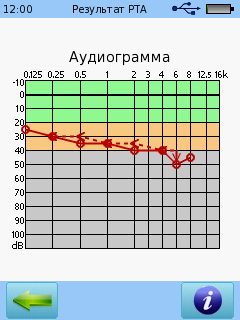

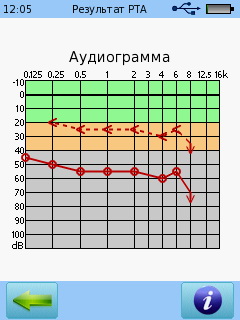

 Українська
Українська Русский
Русский